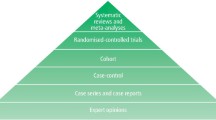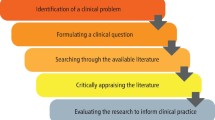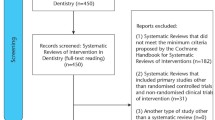Abstract
With the increasing numbers of primary research papers being published in dentistry and healthcare in general, it is almost impossible for busy clinicians to keep up with the literature. Reviews summarising the outcomes of trials can therefore be a considerably efficient tool for obtaining the relevant information about what works and what does not. To this end, systematic reviews are critical in summarising the best available evidence and providing an indication of its strength. However, as with clinical trials, they can be difficult to interpret, of varying quality and dependent on the studies they include. This is the second part of a two-part series and will discuss the principles of critically appraising systematic reviews and meta-analyses. It follows on from part one, which focused on appraising randomised controlled trials.
Key points
-
Well-carried out SRs are extremely efficient for obtaining the 'bottom line' about what treatment modalities work and which do not.
-
Information from SRs can be used to influence decision-making in evidence-based healthcare.
-
Being able to critically appraise SRs is an indispensable and invaluable skill that moves us one step closer to implementing evidence-based practice.
This is a preview of subscription content, access via your institution
Access options
Subscribe to this journal
Receive 24 print issues and online access
$259.00 per year
only $10.79 per issue
Buy this article
- Purchase on Springer Link
- Instant access to full article PDF
Prices may be subject to local taxes which are calculated during checkout





Similar content being viewed by others
References
The Centre for Evidence-Based Management. Critical Appraisal. 2019. Available at https://cebma.org/resources-and-tools/what-is-critical-appraisal/ (accessed January 2021).
Cochrane UK. What are systematic reviews? 2016. Available at https://uk.cochrane.org/news/what-are-systematic-reviews (accessed January 2021).
Davidoff F, Haynes B, Sackett D, Smith R. Evidence based medicine. BMJ 1995; 310: 1085-1086.
Techopedia. Garbage In, Garbage Out (GIGO). 2017. Available at https://www.techopedia.com/definition/3801/garbage-in-garbage-out-gigo (accessed January 2021).
Shea B J, Reeves B C, Wells G et al. AMSTAR 2: a critical appraisal tool for systematic reviews that include randomised or non-randomised studies of healthcare interventions, or both. BMJ 2017; DOI: 10.1136/bmj.j4008.
Moher D, Liberati A, Tetzlaff J, Altman D G., PRISMA Group. Preferred reporting items for systematic reviews and meta-analyses: the PRISMA statement. Ann Intern Med 2009; 151: 264-269.
Moher D, Cook D J, Eastwood S, Olkin I, Rennie D, Stroup D F. Improving the quality of reports of meta-analyses of randomised controlled trials: the QUOROM statement. Quality of Reporting of Meta-analyses. Lancet 1999; 354: 1896-1900.
Stroup D F, Berlin J A, Morton S C et al. Meta-analysis of observational studies in epidemiology: a proposal for reporting. Meta-analysis Of Observational Studies in Epidemiology (MOOSE) group. JAMA 2000; 283: 2008-2012.
Whiting P, Savović J, Higgins J P T et al. ROBIS: A new tool to assess risk of bias in systematic reviews was developed. J Clin Epidemiol 2016; 69: 225-234.
Aromataris E, Fernandez R, Godfrey C M, Holly C, Kahlil H, Tungpunkom P. Summarizing systematic reviews: methodological development, conduct and reporting of an umbrella review approach. Int J Evid Based Healthc 2015; 13: 132-140.
Health Evidence. Quality Assessment Tool - Review Articles. 2018. Available at https://www.healthevidence.org/documents/our-appraisal-tools/quality-assessment-tool-dictionary-en.pdf (accessed April 2021).
Agency for Healthcare Research and Quality. Methods Guide for Effectiveness and Comparative Effectiveness Reviews. 2018. Available at https://effectivehealthcare.ahrq.gov/products/collections/cer-methods-guide (accessed March 2021).
Critical Appraisal Skills Programme. CASP Checklist. 2018. Available at https://casp-uk.b-cdn.net/wp-content/uploads/2018/03/CASP-Systematic-Review-Checklist-2018_fillable-form.pdf (accessed March 2021).
Centre for Evidence-Based Medicine. Critical Appraisal tools. 2021. Available at https://www.cebm.ox.ac.uk/resources/ebm-tools/critical-appraisal-tools (accessed April 2021).
Burns P B, Rohrich R J, Chung K C. The levels of evidence and their role in evidence-based medicine. Plast Reconstr Surg 2011; 128: 305-310.
National Institute for Health Research. Welcome to PROSPERO: International prospective register of systematic reviews. 2021. Available at https://www.crd.york.ac.uk/prospero/ (accessed January 2021).
EMBASE. EMBASE database. 2021. Available at https://www.embase.com/search/quick (accessed January 2021).
Cochrane Library. Central Register of Controlled Trials (CENTRAL). 2000. Available at https://www.cochranelibrary.com/central/about-central (accessed January 2021).
National Library of Medicine. MEDLINE: Overview. 2021. Available at https://www.nlm.nih.gov/medline/medline_overview.html (accessed January 2021).
University of Exeter. Grey Literature: What is Grey Literature? 2021. Available at https://libguides.exeter.ac.uk/c.php?g=670055&p=4756572#:~:text=A%20widely%20accept (accessed January 2021).
Sterne J A C, Savović J, Page M J et al. RoB 2: a revised tool for assessing risk of bias in randomised trials. BMJ 2019; DOI: 10.1136/bmj.l4898.
Page M J, McKenzie J E, Higgins J P T. Tools for assessing risk of reporting biases in studies and syntheses of studies: a systematic review. BMJ Open 2018; DOI: 10.1136/bmjopen-2017-019703.
Yank V, Rennie D, Bero L A. Financial ties and concordance between results and conclusions in meta-analyses: retrospective cohort study. BMJ 2007; 335: 1202-1205.
Cochrane Training. Cochrane Handbook for Systematic Reviews of Interventions. 2021. Available at https://training.cochrane.org/handbook (accessed March 2022).
Royle P, Waugh N. A simplified search strategy for identifying randomised controlled trials for systematic reviews of health care interventions: a comparison with more exhaustive strategies. BMC Med Res Methodol 2005; DOI: 10.1186/1471-2288-5-23.
Guyatt G, Oxman A D, Akl E A et al. GRADE guidelines: 1. Introduction-GRADE evidence profiles and summary of findings tables. J Clin Epidemiol 2011; 64: 383-394.
Graciela Rasines Alcaraz M, Veitz-Keenan A, Sahrmann P, Schmidlin P R, Davis D, Iheozor-Ejiofor Z. Direct composite resin fillings versus amalgam fillings for permanent or adult posterior teeth. Cochrane Database Syst Rev 2014; DOI: 10.1002/14651858.CD005620.pub2.
Choi S W, Lam D M. Funnels for publication bias - have we lost the plot? Anaesthesia 2016; 71: 338-341.
Author information
Authors and Affiliations
Contributions
Aslam Alkadhimi contributed to conceptualisation, literature search, original draft preparation, drafting and critically revising the manuscript; Samuel Reeves contributed to original draft preparation and editing; and Andrew T. DiBiase contributed to supervision, draft editing and critically revising the manuscript.
Corresponding author
Ethics declarations
The authors declare that there are no competing interests.
Ethics approval and consent/availability of data and material was not applicable for this study.
Rights and permissions
About this article
Cite this article
Alkadhimi, A., Reeves, S. & T. DiBiase, A. How to appraise the literature: basic principles for the busy clinician - part 2: systematic reviews and meta-analyses. Br Dent J 232, 569–575 (2022). https://doi.org/10.1038/s41415-022-4151-8
Received:
Accepted:
Published:
Issue Date:
DOI: https://doi.org/10.1038/s41415-022-4151-8
This article is cited by
-
PRISMA 2020 updated guideline
British Dental Journal (2022)



